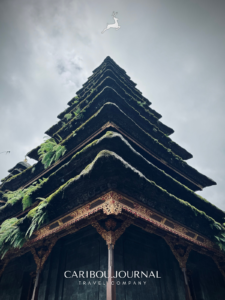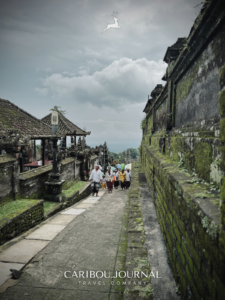


𝗕𝗲𝘀𝗮𝗸𝗶𝗵, T𝗵𝗲 S𝗮𝗰𝗿𝗲𝗱 M𝗼𝘁𝗵𝗲𝗿 T𝗲𝗺𝗽𝗹𝗲 𝗼𝗳 𝗕𝗮𝗹𝗶.
Besakih Temple, so called Pura Besakih by Balinese people is the biggest Temple in Bali and it is considered to be the most significant temple in Balinese Hindu religion. Built majestically on the western slope of Mt. Agung, the Greatest Volcano in Bali.
Location
Besakih Temple located in Karangasem Regency, the eastern part of Bali. As we mentioned previously, Besakih Temple built on the South-West slope of Mt. Agung, believed as the Holiest and the Greatest Volcano in Bali. It makes Besakih Temple has cool atmosphere, and it’s aura feels sacred (For us as Balinese people, it different with any other temple in Bali).
This majestical temple is accessible from any place in Bali. For example, if you start from Kuta, Sanur, Canggu, Nusa Dua, or Denpasar Area, you can go through beach-side bypass route called Ida Bagus Mantra Street. Then, you will first get to pass Klungkung Regency. You can have a break at Kerta Gosa monument and food hunting on Klungkung Traditional Market. You can find several shops that sell “Nasi Campur Ayam”, which consist of chicken (Ayam), vegetables, and several Bali traditional Seasoning. You can mark it in google maps: . Tips 101, always remember that Balinese traditional seasoning is quite spicy. Hence, you might get Bali belly.
After that, the trip continued to the north direction. You will go through a beautiful natural village called Rendang. If you have reached this village, it means that you already enter Karangasem regency. In Rendang, there are several vendors which provides Rafting activity at Tlaga Waja river. It can give you challenging adventure experience. But our suggestion in case you want to try this rafting activity, you can put it on the return trip. From rendang, you will reach Besakih Temple around 15-20 minutes with uphill tarmac road. Finally, you will get to Besakih Temple. Total duration that you will take for this trip for the area that we mentioned above is around 2 – 3 hours (Around 70 kilometers from Kuta Area) with low traffic level, depends how many pit stop that you take, travelers.
The Sacred History of Besakih Temple.
Besakih is well known as the “Mother” of all temple in Bali, or “Mother of Temple” and had been used as the cultural icon of Bali. There is an ancient rich sacred story behind this. The story began more the thousand years ago, in 1924. The story of the construction of Besakih temple correlated with Hindu’s religious figure that spread Hindu’s religion in Bali, the great sage Markendya “Maha Rsi Markendya”. He is the son of Sang Merkanda and Dewi Manaswini.
The great sage Markendya was a sage that came from Markandya mountains in India. He initially lived in Dieng mountain area and for retreat place in the Ancient Mataram Kingdom area (Currently Central of Java Province). Since there was a great natural disaster at that very moment, the center of Ancient Mataram Kingdom was moved to East Java. Following that situation, the great sage Markendya was also moved to East of Java and finally settled in the Raung Mountain to begin his spiritualism meditation.
During the meditation at Raung mountain, the great sage Markendya received the guidance to continue his Journey to the East, namely the island of Bali. Before the great sage Markendya came to Bali, there were already people who were in Bali, namely people of Austronesian descent. Austronesian people had already spread throughout Bali. They lived with their respective leaders. This group would later became forerunner of the villages in Bali, so called Bali Mula. They did not practice the religion, they only worshiped the spirits of their Ancestors.
At the first sail to Bali, the great sage Markendya accompanied by 800 followers from Aga people. They came to Bali by crossed Segara Rupek (Marine area that now called the Bali strait). Following the guidance in his retreat, they went to Agung Mountain area as their first destination. In that area, they began to open the land for settlement and agriculture. However, his followers death mysteriously attacked by wild animals or infected by mysterious disease. Hence, their first arrival to Bali came to end conclusion as Failure. Because of that serial condition, the great sage Markendya returned to his retreat place in the East of Java, Raung mountain asked for guidance.
As a result of his retreat, the great sage Markendya received a guidance to perform “Yadnya” e.g ceremony so called “Mecaru” before starting construction process including to plant the five elements of “Panca Datu” metal (gold, silver, copper, bronze, iron, and is accompanied by “Mirah Adi” (main gem)). “Panca” means five, and “Datu” means watu = batu = stone = metal. After convinced with the guidance he received in his retreat, the great sage Markendya went to bali followed by 400 of his followers. They went to south-west slope of Agung mountain and performed the “Mecaru” at that place. Finally, his followers survive the journey to Bali. The place that they planted the five elements “Panca Datu” developed become Besakih Temple.
The Mother Temple of Bali.
Following the history of the journey of the great sage Markendya, it is known that the objective of his journey was to spread Hindu’s religion to Bali. And Besakih was the first temple that built in Bali by the great sage Markendya on his journey to spread Hindu’s religion. Following the essence of “Mother” that give birth to her child, Besakih is called the “Mother Temple” because it is the first temple and initiate the needs of construction of other temples in Bali. In his journey to Bali, the great sage Markendya built many holy temple such as Payogan Agung Gunung Lebah Temple in Ubud.
The Name of Besakih.
The name of Besakih itself close to Sansekerta language, “Wasuki” or also called “Basuki” in the ancient language of Java, that means “Safety”. In the other version, the name of Besakih also has correlation with Naga Basuki (Basuki Dragon), which believed to be the Balance of Mount Mandara in Hindu cosmology. Basuki Dragon also believed as the guardian which stays in Agung Mountain that brings the safety and the prosperity to the people surround of Agung Mountain. This mythology increase the spiritualism energy and the symbolic meaning of Besakih Temple/Pura Besakih for the Balinese Hindu community.
The Marvel Architecture of Besakih Temple.
The sacred temple of Besakih consists of 26 Temples. 1 is the Main Temple so called “Penataran Agung Temple”, then other 25 temples are the surrounding temple. The surrounding Temples are Gelap Temple, Ulun Kulkul Temple, Batu Madeg Temple, Several Temples for Balinese Hindu’s family based on vertical lineage, and so on.
These Besakih Temple complex is the masterpiece of Traditional Bali’s Architectural concept. The great Besakih Temple possess the unique culture of Bali which based on “Tri Hita Karana”. Which consist of the relations between human and God (Parahyangan), human to human (Pawongan), and human to nature (Palemahan). These three relations are believed to bring the harmony, so called Tri Hita Karana.
The structure of Besakih Temple is really majestic, with boasting towering pagodas which called by “Meru”, beautiful stone carvings, and a pretty intricate/sophisticated temple design.
- Meru, The soaring high Pagoda
The tall building which seen and provide majestical atmosphere in Besakin is called by Meru. It represents the sacred Meru mountain, believed as the center of the the Universe in Hindu religion. It has multi-staging or multi-tier concept which represent the universe (Bhuana Agung). The stage of Meru starts by 1, and it’s highest stage/tier of Meru is 11. Each stage or tier of Meru covered by sophisticated carves and decorative motifs, showing the scenes of Hindy Mythology and the epic story of Mahabharata and Ramayana. - Hand Crafted Relief and Stone Carving
Almost all of each wall, block, woods, stone in Besakih was decorated by handcrafted relief and stone carvings. This is the cultural expression to pour the artistical spirit of Balinese people, acting as the showcase of the exceptional craftsmanship skills. These craftmanship featured Hindu’s deities, celestial beings, and the mythological story, and each has it’s Symbolic meaning. - Candi Bentar, the Magnificient gate building
The gate of Besakih are marked by magnificient stone gateways. It is known as Candi Bentar by Balinese people. In the Balinese Hindu’s concept, this Candi Bentar serve as the portal between the outer world and the sacred inner space. Candi Bentar structure are decorated with sophisticated carvings and sculptural details, such as mythical creatures called Kala Matara. It symbolize the forces of creation and destruction, depicted with the head of Lion and the body of Sea Monster.
Tri Mandala Concept, the Terrace Architectural Concept of Besakih.
There are several concept in Balinese Original Architecture which called Asta Kosala Kosali, Sanga Mandala, and Tri Mandala, which are the simplify concept of Sanga Mandala. The Besakih Temple actually adopt both of this concept. However, in this opportunity we will focus on Tri Mandala Concept.
Tri Mandala Concept divides temple or residential area by 3 sections. They are Nista Mandala, Madya Mandala, and Utama Mandala. It represents the order from the Lowest to the Highest respectively. In Balinese Hindu religion, we used several parameters to determine the tier utilizing Mountain and Sunrise believed as the highest point where Ida Sang Hyang Widi and the deities resides, represented by North and East direction. The Outer space also considered to be the lowest point such as street, rivers, south/west, and lowest altitude. The Inner space considered as the highest point such as trees, mountain, and higher altitude.
-
- Nista Mandala, the Lowest area
This area is part of the border or courtyard around the main prayer room which is more public or open. Its function is as the first approach area to the holy place. It is usually utilized as the place for parking, place to throw the garbage, and anything else. - Madya Mandala, the Middle Area
Madya Mandala is the area between Utama Mandala and Nista Mandala. This section is a corridor or courtyard that approaches the sacred center space. Usually this is the maximum space that the people can visit except they are going to Besakih for praying. - Utama Mandala, the Main Sacred Area
Utama Mandala is the holiest and deepest area in a place of worship. This place is a temple, shrine, or other sacred structure that is usually used as a place for rituals or worship. Only people who have passed Nista Mandala and Madya Mandala are allowed to enter Utama Mandala. Worshippers in this place perform meditation, prayer, or other religious rites.
- Nista Mandala, the Lowest area
Besakih Temple hold the role as the center of Dewata Nawa Sanga, the 9 guardians of Bali, consider Besakih Temple is the first temple in Bali and located in the center of Bali, built in the greatest mountain in Bali, Agung Mountain. Thus Besakih Temple is dedicated to the Hindu trinity of Brahma, Vishnu, and Shiva, The Tri Murthi, along with other Deities. Each divine being is significant in Balinese Hinduism.
- Brahma: believed as the creator god. Brahma is worshipped as the creator of life and the universe. Prayers seek Brahma’s blessings for creativity, knowledge, and enlightenment.
- Vishnu: believed as the guardians of the universe, revered for the role in maintaining order and harmony of the universe. Prayers seek Vishnu’s blessings for protection, sustenance, and spiritual guidance.
- Shiva: believed as the demolisher and the transformer. Shiva is worshipped as the embodiment of cosmic energy and divine power. Prayers seek Shiva’s blessings to liberate themselves from worldly attachments and attain spiritual enlightenment.
Not only Tri Murthi, Besakih Temple also honours other deities and celestial beings, including Saraswati, Ganesha, Dewi Danu, and the Ancestors of ancient Balinese vertical blood line. The ancestors believed posses the role to spread Hindu’s religion across Bali island and forming their family and descendants continued until present time. This formed the “Pedarman” which divides Balinese Hindu community into 17 Pedarman.
Deities Worshiped at Besakih Temple:
Brahma, Vishnu, Shiva (Tri Murthi)
The Ceremonies Conducted in Besakih Temple
- Eka Dasa Rudra, the biggest “Yadnya” in Besakih which conducted once in 100 years
Eka Dasa Rudra is held every 100 years when the units and tens digits of the Saka year reach 0, also called Rah Windu Tegek Windu. In the records of Besakih temple, the last Tawur Agung Eka Dasa Rudra was conducted in 1979, precisely on Buda Paing Wariga on March, 28th 1979 in accordance with the calculation of the Saka year rotation when the units and tens reach zero, namely in the Saka year 1900. Due to the long periods of Balinese Saka calendar, it is possible for 1 generation do not meet the Eka Dasa Rudra. - Panca Wali Krama, the “Yadnya” which conducted once in every 10 years
The objective of this ceremony is to maintain the harmony of the universe (Bhuana Agung) and neutralize the upper (Utama Loka), middle (Madya Loka), and lower (Nista Loka) nature. The last series of Panca Wali Krama was conducted January 22nd until March 20th
Because it happens once in every 10 years, many Hindu’s religion community from outside Bali island including India come to Besakih for praying. - Piodalan of Besakih Temple
Piodalan, which known as the “Anniversary” of Besakih Temple is one of the most vibrant and significant religious event. It is celebrated once in every 210 days according to the Balinese calendar, Saka. In Saka, 1 month consists of 35 days, makes it 6 months in Saka is equal to 210 days. It typically attracts thousands of prayers from across Bali who pay homage to the deities and seek blessings for prosperity, health, and spiritual well-being.
Other than these 3 ceremonies, Besakih Temple hosts a variety of other ceremonies throughout the year, each dedicated to specific deities and aspects of Balinese Hinduism. These ceremonies include Purnama (full moon ceremonies), and Galungan-Kuningan (celebrations of the victory of dharma over dharma).
How to Visit Besakih Temple
The strong Hindu’s cultural aspect makes Besakih exceptional. Furthermore, the view from Besakih to the south part of Bali is beautiful causing great admiration. The great news is Besakih temple opens for visitors around the world.
- Operational Hours:7 AM to 6 PM daily. However, the visitors may not be allowed to enter the temple while there is a Balinese Hindu ceremonial, nor the woman who’s in their periods aren’t allowed to enter the Temple.
- Entrance fee: IDR 80,000 for IDN citizen and IDR 150,000 (Around 12 USD) for Foreigner. Inclusion: Local Tour Guide, Renting of the Balinese Hindu’s Traditional Clothes, and Electrical Commuter vehicle.
Tips to Visit Besakih Temple
- Wear modest clothing
Remember, Besakih is a holy temple. So, always care on the way you dress in Besakih Temple Area - Always Follow the Rules
It is very important to respect and follow the rules that applied in Besakih Temple. Don’t use flashlight to the people who are praying, don’t climb it’s wall or it’s sacred temple, don’t disturb Hindu’s community who are praying. - The Best time for visiting
Early morning or afternoon visiting time is recommended for cooler air temperature and less visitors. Visiting Besakih in Purnama or Piodalan ceremony will give you the unique experience. Besakih will be closed for visitor in Big Ceremony event, so always ask your guide/travel agency to confirm. - Use the service of Local Guide
The area of Besakih temple are wide. Local guide can give you best experience. In addition, they can support you to understand the symbol, history, and ceremonial events in Besakih temple. - Prepare your Energy
Because the area of Besakih temple are so wide and it has terrace character following the landscape characteristic, you may need to walk in a long distance and climb several stairs. So, make sure you are ready physically and have good rest the day before. There are several shops opened in Besakih for you to buy water and snacks. You can also try “satay” the local food of Bali in the temple area.
Samsara Living Museum
Discover the authentic of Bali in Samsara Living Museum, Bali LocationThis original Balinese...
Karting Star Bali
Sharing our experience at Karting Star Bali, the best go-kart track in Bali. Location This amazing...





